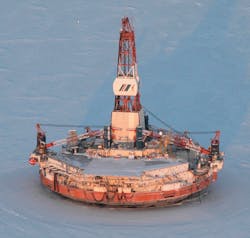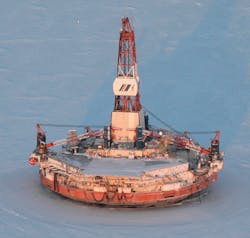USCG: 'Chain of errors' led to Shell drilling unit running aground
Michael T. Slocum
Upstream Technology Editor
A US Coast Guard (USCG) investigation has found that a "chain of errors" led to the Royal Dutch Shell PLC conical drilling unit, the Kulluk, running aground on Sitkalidak Island, Alas., in December 2012 (OGJ Online, Jan. 2, 2013). The primary cause was attempting a winter voyage in the Arctic with ineffective risk assessment and management, according to USCG's report, which was released Apr. 2.
The Kulluk broke free while being towed in heavy seas by Edison Chouest Offshore's vessel, the Aiviq. There was no oil spill associated with the incident. The drilling unit was later salvaged and towed to an Asian dry dock for inspection and repairs. (OGJ Online, Feb. 13, 2013).
Complex series of events
USCG's investigation report describes a "complex series of events" that included inclement weather, seas of 20 ft, an inadequate tow plan, the Kulluk's conical hull (see figure, OGJ, Oct. 1, 2007, p. 40), faulty tow shackles, engine failure, and human error.
"The most significant factor was the decision to attempt the voyage during the winter in the unique and challenging environment of Alaska," said USCG Rear Adm. T.P. Ostebo. "Shell and Edison Chouest Offshore's ineffective risk management and application of towing measures for the voyage also contributed to the grounding."
During the USCG's 9-day investigative hearing in 2013, Shell's Alaska operations manager testified that the Kulluk was moved due to "financial considerations," contradicting previous claims that fair weather had prompted the move. If Shell had not moved the drilling unit, it would have been liable for $6 million in taxes.
USCG recommendations
The USCG offered nine recommendations to mitigate the possibility of a similar incident. Most of these are aimed at towing vessels, and include stricter standards and certification policies, better training, and the inclusion of the Safety Management System on all vessels.
For Shell, or any company intending to operate in the Arctic, the report offers recommendations, as well. It calls for the inclusion of tow plans in any policies that address marine operations, and the establishment of additional criteria for operations in areas of historical heavy weather.
Specifically, the report tasks Shell with reconsidering its criteria for tow routing, assessing the suitability of its tow vessels, creating contingency plans including harbors of safe refuge, and employing towing equipment that is sized and configured for anticipated environmental conditions. An "acceptable" third-party will ensure Shell meets these criteria.
Mixed reactions
Reactions to the report in Washington, DC, were mixed. Sen. Lisa Murkowski (R-Alas.) commended the USCG's investigation and its recommendations to improve the safety of maritime activities as exploration in the Arctic moves forward.
"I believe that we can safely develop our energy resources in the Arctic, but it requires that we adhere to world-class safety standards," she said.
However, Sen. Ed Markey (D-Mass.), a member of the Senate Commerce and Environment Committee, believes Shell's disregard for safety should serve as a warning, particularly if it was motivated for financial reasons.
"This kind of behavior should raise major red flags for any future Arctic drilling plans," he said.
Cindy Shogan, Alaskan Wilderness League executive director, claims the report demonstrates that no company is ready to drill in the harsh, unpredictable conditions of Alaska. Her organization has called for US President Barack Obama to place a moratorium on Arctic Ocean drilling.
Shell's Arctic 'pause'
In February 2013, Shell announced it would "pause" its exploration drilling activity for the remainder of the year in Alaska's Beaufort and Chukchi seas to prepare equipment and make plans for how and when to resume activity in the Arctic (OGJ Online, Feb. 27, 2013).
A request sent to Shell for comment on the USCG report or its future plans in Alaska went unanswered.
In a statement issued last year, Shell's Marvin Odum, director, upstream Americas, noted that the company remained committed to building an Arctic exploration program and continued to believe that a measured and responsible pace, especially in the exploration phase, fits best in the Arctic.

